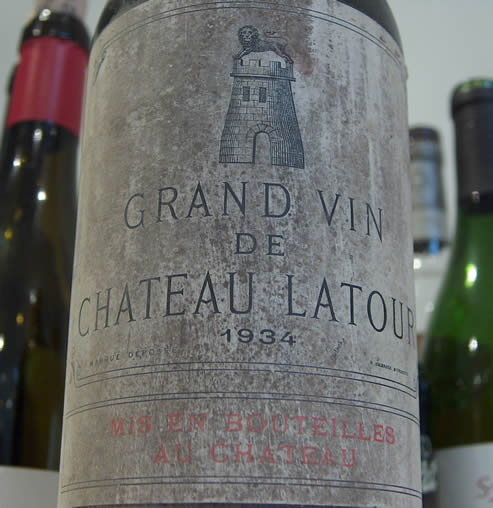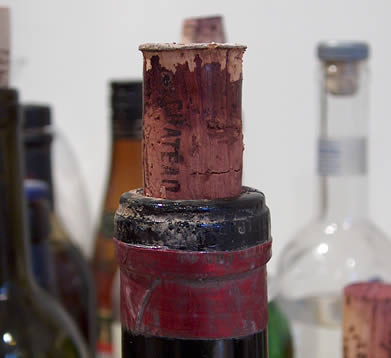|
Extended
tasting note 12
Château
Latour 1934

Portuguese winemaker (and serious wine nut) Dirk
Niepoort was staying, and he brought a bottle with him for dinner.
‘Do you like old wine?’ he asked me. He then produced a pristine
bottle of 1934 Château Latour.
 With
old wines, provenance is everything, and this had come from an
impeccable cellar. Every serious collector I have spoken to recognizes
the importance of a cold, damp cellar for preserving old wines, and
under these conditions corks are remarkably long lived. This bottle
demonstrated this perfectly: the cork, which had been in the bottle
neck for 70 years, was still supple and elastic, and had protected the
wine fantastically. When you open a bottle this old, there’s a sense
of anticipation. You don’t know what you are going to find: it could
be a majestic wine; it could be dead as a dodo. With
old wines, provenance is everything, and this had come from an
impeccable cellar. Every serious collector I have spoken to recognizes
the importance of a cold, damp cellar for preserving old wines, and
under these conditions corks are remarkably long lived. This bottle
demonstrated this perfectly: the cork, which had been in the bottle
neck for 70 years, was still supple and elastic, and had protected the
wine fantastically. When you open a bottle this old, there’s a sense
of anticipation. You don’t know what you are going to find: it could
be a majestic wine; it could be dead as a dodo.
We poured a glass. It was clear and bright; a
reassuringly dark colour, with only a little fading at the rim. It’s
hard to believe that this was a 70 year old wine. The nose is lovely.
Deep, dark and spicy with a touch of meaty complexity. Very pure.
There is a haunting green aspect in the background, but this is
definitely good green.
The palate is amazingly youthful, with lovely grippy
tannins. There’s some sweet red fruits and lovely elegance. Just a
tiny bit medicinal, but pure and focused with good acidity. It’s a
stunning wine; almost perfect. It seems daft to rate a wine like this,
but if I’m pressed I’ll give it 98/100 (that’s just about as
high as my scores go; I worry about scoring higher, because it leaves
no further room – and what if I meet a better wine?).
Drinking a wine like this offers an amazing window into
the past, even if the connection is more emotional than real. In 1934
Europe and the USA were just recovering from the great depression.
This was the year that Hitler assumed the role of Fuhrer of Germany.
Neither of my parents had been born. The world was quite a different
place to how it is now, but here we are drinking a wine that was a
product of that summer.
For me, this is an important wine. It makes me think
about some of the issues surrounding fine wine. This Latour is
fantastic now, but what would it have tasted like young? Dirk and I
discussed how we would pay a lot of money to drink this wine young,
because we would have learned a lot from it. I reckon it wouldn’t
have been ripe, fleshy and sweet in its youth. Bordeaux was quite
different in 1934 to how it is today. These days, there is an aversion
to any hint of greenness in a young wine. But this wine young would
likely have had a bit of greenness – good greenness – in its
youth. It would also likely have been massively structured.
The modern trend is for more concentrated, riper wines
with sweeter fruit and smooth tannic structure. This has extended to
Bordeaux. Advances in the vineyard and greater selection in the cellar
have accentuated this trend, making wines that are drinking better
younger. Of course, if a Château wants to pursue this
course, that’s their right, and it’s up to the public to decide
whether or not to buy the wines—it’s not ‘wrong’ to make wines
like these. But the cost could be the loss of bottles like this
majestic 1934 Latour. I would dearly love to see the 1934 Latour aged
18 months being put into a modern Bordeaux en primeur line up. Would
it be sweet and opulent, as some are claiming (the idea being that the
old wines that are best now are those that came from the ripest,
hottest vintages)? Or would it be dismissed as green and tannic? Yes,
I reckon there would have been plenty of fruit there, but I also think
by todays standards it would be seen as uncompromisingly structured,
and perhaps even a little rustic in its infancy. Wines that taste
great old don’t necessarily taste great young.
This bottle also re-emphasized to me the importance of
having a cold, damp cellar. I need to buy an old house with such a
cellar, and I need to get my hands on more old, well cellared wine.
Other
ETNs:
Grünhaus;
Roc des Anges; Gaillard;
Veratina; Arturo;
Wynns; Drystone;
Foundry and Columella; Meruge;
Foillard Morgon; Clonakilla
tasted
05/06
Back to top
|

